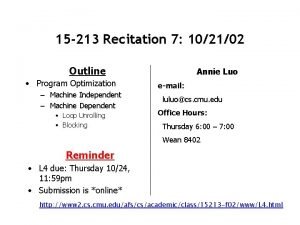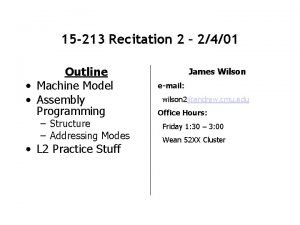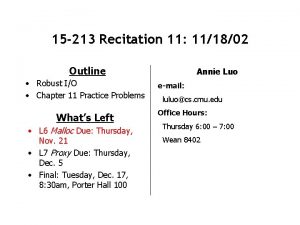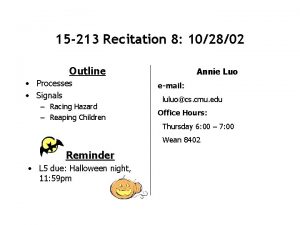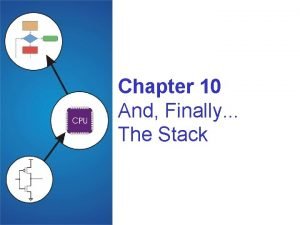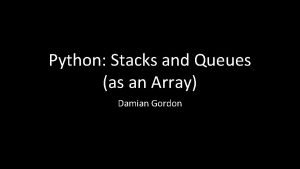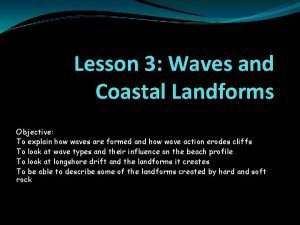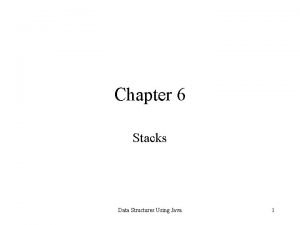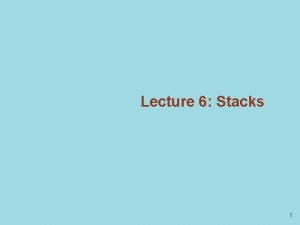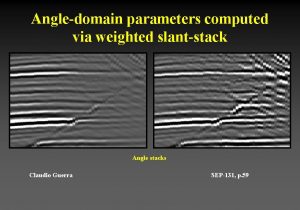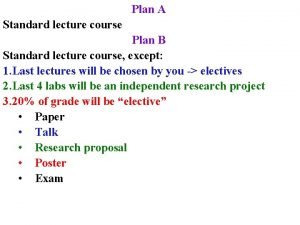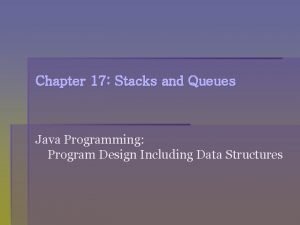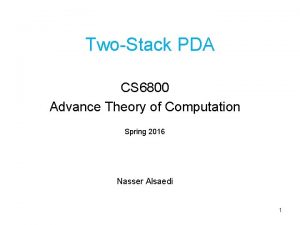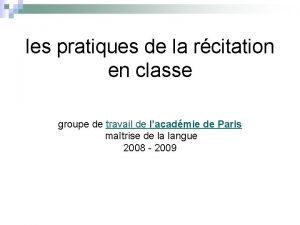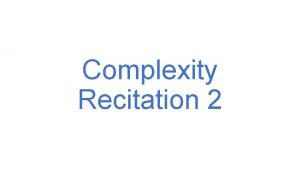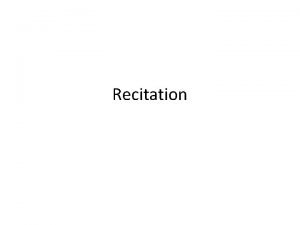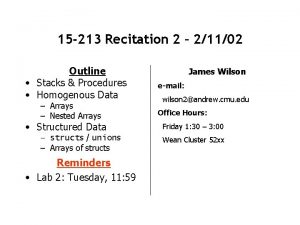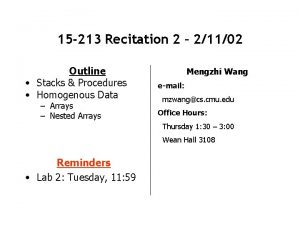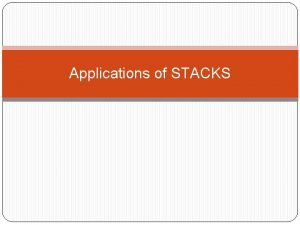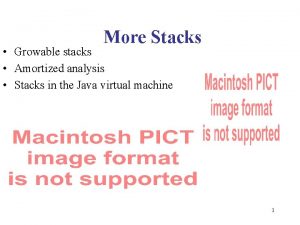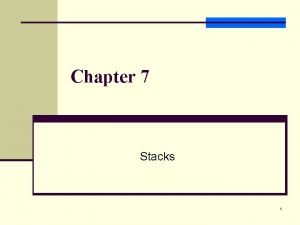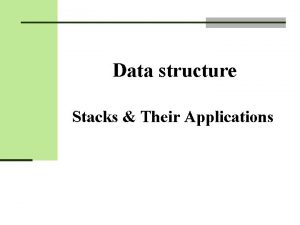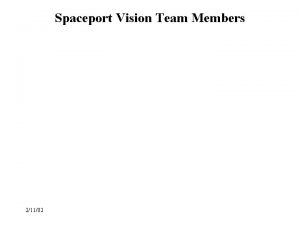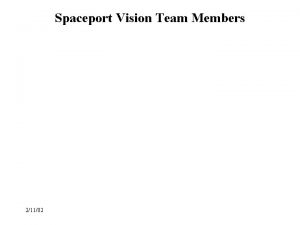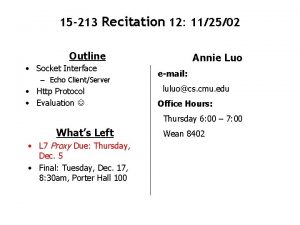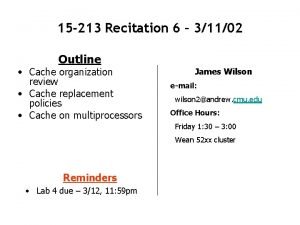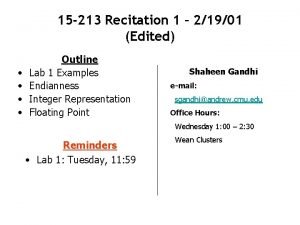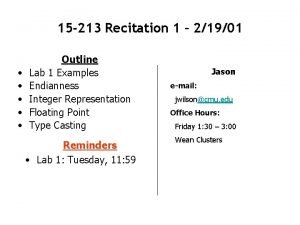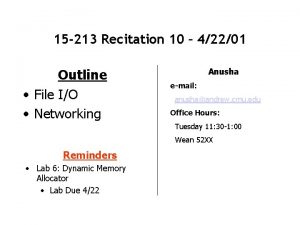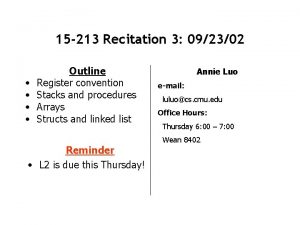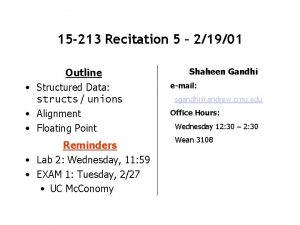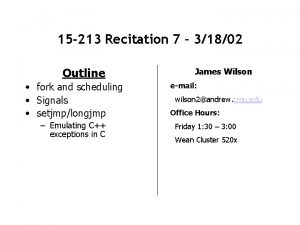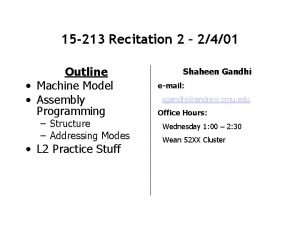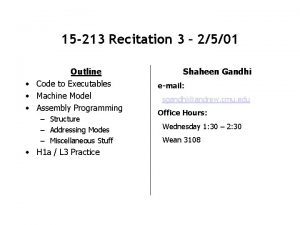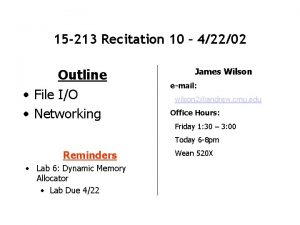15 213 Recitation 3 21102 Outline Stacks Procedures



























- Slides: 27

15 -213 Recitation 3 – 2/11/02 Outline • Stacks & Procedures • Homogenous Data – Arrays – Nested Arrays • Structured Data – structs / unions – Arrays of structs Reminders • Lab 2: Tuesday, 11: 59 Trent e-mail: mmt@cmu. edu Office Hours: Thursday 12: 30 – 2: 00 Wean Hall 3108

Stacks • • Grows down Stores local variables that can’t fit in registers Stores arguments and return addresses %esp Stack Pointer – • %ebp – • Base Pointer Points to a function’s stack frame pushl – • Points to the top value on the stack Decrements, then places value popl – ‘Returns’ value, then increments

Stack Frames • • Abstract partitioning of the stack Each Frame contains the state for a single function instant Caller Frame Arguments Frame Pointer (%ebp) Return Addr Old %ebp Saved Registers Local Variables Stack Pointer (%esp) Argument Build

Procedures • call: Caller Responsibilities Arguments (pushl) – • • In what order? Return Address (done by call) ret: Callee Responsibilities Save Registers (especially %ebp) Set up Stack Frame Return value in %eax

Problem 1: Call Chain void absdiff(int *result, int x, int y) { int z; int main() { int result; int x, y; x = 5; y = -3; absdiff(&result, x, y); printf("|(%d) - (%d)| = %dn", x, y, result); if (x >= y) z = x - y; else z = y - x; *result = z; return; } return 0; }

Problem 1: Answer <main>: push mov sub movl add mov push lea push call Old %ebp %esp, %ebp $0 x 18, %esp $0 x 5, -8(%ebp) $0 xfffffffd, -12(%ebp) $0 xfffffffc, %esp -12(%ebp), %eax -8(%ebp), %eax -4(%ebp), %eax <absdiff> %ebp result 5 -3 %esp -3 5 &result Rtn Address %esp

Problem 1: Answer <absdiff>: push mov sub mov cmp jl mov mov sub jmp. L 1 mov mov sub. L 2 mov mov pop ret * %ebp %esp, %ebp $0 x 18, %esp 0 xc(%ebp), %eax 0 x 10(%ebp), %eax. L 1 0 xc(%ebp), %eax 0 x 10(%ebp), %edx %eax, %ecx %edx, %ecx. L 2 0 x 10(%ebp), %eax 0 xc(%ebp), %edx %eax, %ecx %edx, %ecx 0 x 8(%ebp), %eax %ecx, (%eax) %ebp, %esp %ebp * * %esp -3 5 &result Rtn Address Old %ebp %esp

Problem 1: Answer Old %ebp <main>: …. . add mov push call mov pop ret %ebp result $0 x 10, %esp -4(%ebp), %eax -12(%ebp), %eax -8(%ebp), %eax $0 x 80484 d 8 <printf> %ebp, %esp %ebp 5 -3 %esp result -3 5 $0 x 80484 d 8 Rtn Address %esp

Problem 2: Recursion With the following code, what does the stack look like if we call fib(1, 1, 0) and reach the point where if(n==0) holds true? int fib(int n, int next, int result) { if(n == 0) return result; return fib(n - 1, next + result, next); }

Problem 2: Answer 0 1 1 ret oldebp 0 1 0 ret oldebp ; ; ; ; ; third argument to fib second first call fib <--- ebp of fib’s caller <--- push result <--- next + result <--- n - 1 call fib

Homogenous Data: Arrays • Allocated as contiguous blocks of memory Address Computation Examples • • int cmu[5] = {…} cmu begins at memory address 40 cmu[0] cmu[3] cmu[-1] cmu[15] 40 40 + + 4*0 = 40 4*3 = 52 4*-1 = 36 4*15 = 100

Problem 3: Arrays get_sum: pushl %ebp movl %esp, %ebp pushl %ebx . L 6: . L 4: movl 8(%ebp), %ebx movl 12(%ebp), %ecx xorl %eax, %eax movl %eax, %edx cmpl %ecx, %eax jge. L 4 addl (%ebx, %edx, 4), %eax incl %edx cmpl %ecx, %edx jl. L 6 popl %ebx movl %ebp, %esp popl %ebp ret # # # # # ebx ecx eax edx = = 1 st arg 2 nd arg 0 0 if (ecx >= 0) goto L 4 eax += Mem[ebx+edx*4] edx ++ if (edx < ecx) goto L 6

Problem 3: Answer get_sum: pushl %ebp movl %esp, %ebp pushl %ebx . L 6: . L 4: movl 8(%ebp), %ebx movl 12(%ebp), %ecx xorl %eax, %eax movl %eax, %edx cmpl %ecx, %eax jge. L 4 addl (%ebx, %edx, 4), %eax incl %edx cmpl %ecx, %edx jl. L 6 popl %ebx movl %ebp, %esp popl %ebp ret int get_sum(int * array, int size) { int sum = 0; int i=0; for (i=0; i<size; i++) sum += array[i]; return sum; }

Problem 4: Nested arrays int main(int argc, char **argv) { int i, j, r=0; for (i=0; i<argc; i++) { j=0; while(argv[i][j] != '�') { r ^= argv[i][j]; j++; } } return r; }

Problem 4: Answer. L 9: main: pushl %ebp movl %esp, %ebp pushl %edi pushl %esi pushl %ebx movl 12(%ebp), %edi xorl %esi, %esi xorl %ebx, %ebx cmpl 8(%ebp), %esi jge. L 4. L 6: xorl %ecx, %ecx movl (%edi, %ebx, 4), %eax cmpb $0, (%eax) je. L 5 movl %eax, %edx movsbl (%ecx, %edx), %eax xorl %eax, %esi incl %ecx cmpb $0, (%ecx, %edx) jne. L 9. L 5: incl %ebx cmpl 8(%ebp), %ebx jl. L 6. L 4: movl popl movl popl ret %esi, %eax %ebx %esi %edi %ebp, %esp %ebp

structs and unions • Organize data • structs store multiple elements, unions store a single element at a time • Members of a union change how you look at data • unions used for mutually exclusive data

Alignment • • Contiguous areas of memory Each block is aligned – Size is a multiple of a base value – “Base value” is the largest alignment of data types in structure • Why? – Efficient load/store from memory – Virtual Memory paging • This applies to any variable type

Structure of a struct • Find largest alignment – • Size of structure must be a multiple of this For each element e (top to bottom): – Find alignment of e • – – • • Starting offset must be a multiple of this Pad previous element with empty space until alignment matches Allocate alignment worth of space to e Pad last element with empty space until alignment of structure matches Note this isn’t optimal!

Structure of a union • Find largest alignment – • Size of structure must be a multiple of this Allocate this much space struct one { int i; double d; char c[2]; } Examples union two { int i; double d; char c[2]; }

Problem 5: Structs. LC 0: . string. LC 1: . string. LC 2: . string. align 32. LC 3: . string main: pushl movl #define MAX_STRING 20 "Jack" "Black" "12345 ZXY" "Name : %s %sn. ID : %sn. Age : %in“ #struct #{ # char # int #}; student first [ MAX_STRING ]; last [ MAX_STRING ]; id [ MAX_STRING ]; age; %ebp %esp, %ebp subl pushl leal pushl call $88, %esp $4, %esp $5 $. LC 0 -72(%ebp), %eax strncpy addl subl pushl leal addl pushl call $16, %esp $4, %esp $6 $. LC 1 -72(%ebp), %eax $20, %eax strncpy # struct student s 1; # struct student *s 2; # strncpy(s 1. first, f. Name, # sizeof(f. Name)); # strncpy(s 1. last, l. Name, # sizeof(l. Name));

Problem 5: Structs addl subl pushl leal addl pushl call $16, %esp $4, %esp $9 $. LC 2 -72(%ebp), %eax $40, %eax strncpy addl movl $16, %esp $19, -12(%ebp) leal movl -72(%ebp), %eax, -76(%ebp) subl movl pushl movl addl pushl call $12, %esp -76(%ebp), %eax 60(%eax) -76(%ebp), %eax $40, %eax -76(%ebp), %eax $20, %eax -76(%ebp) $. LC 3 printf addl movl leave ret $32, %esp $0, %eax strncpy(s 1. id, ID, sizeof(ID)); # s 1. age = AGE; # s 2 = &s 1; # printf("Name : %s %sn. ID : %sn. Age : %in", # s 2 ->first, s 2 ->last, s 2 ->id, s 2 ->age); # clean up and exit

Problem 5: Answer int main ( int argc, char** argv ) { struct student s 1; struct student *s 2; strncpy ( s 1. first, f. Name, sizeof ( f. Name ) ); strncpy ( s 1. last , l. Name, sizeof ( l. Name ) ); strncpy ( s 1. id , ID , sizeof ( ID ) ); s 1. age = AGE; s 2 = &s 1; printf ( "Name : %s %sn. ID : %sn. Age : %in", s 2 -> first, s 2 -> last, s 2 -> id, s 2 -> age ); return 0; }

Problem 6: Arrays of structs. LC 0: . string "%i : %s - “. LC 1: . string "Has no partnern“. LC 2: . string "Partnered with : %s n“. align 32. LC 3: . string "Claims parter: %s, but not mutualn“ partner_check: pushl %ebp movl %esp, %ebp subl $20, %esp pushl %ebx nop movl $0, -4(%ebp). p 2 align 4, , 7. L 3: cmpl $5, -4(%ebp) jle. L 6 jmp. L 4. p 2 align 4, , 7. L 6: addl $-4, %esp movl -4(%ebp), %eax movl %eax, %ecx movl %ecx, %edx sall $4, %edx addl %eax, %edx #define MAX_STRING 20 #define MAX_STUDENTS 6 #struct student #{ # char first [ MAX_STRING ]; # char last [ MAX_STRING ]; # char id [ MAX_STRING ]; # int age; # struct student *partner; #}; # # < < < Lines with < symbols are moving data for the printf command at the end of the < block. left in for informational purposes

Problem 6: Arrays of structs leal 0(, %edx, 4), %eax movl %eax, %edx addl 8(%ebp), %edx leal 40(%edx), %eax pushl %eax movl -4(%ebp), %eax pushl $. LC 0 call printf addl $16, %esp movl -4(%ebp), %eax movl %eax, %ecx movl %ecx, %edx sall $4, %edx addl %eax, %edx leal 0(, %edx, 4), %eax movl 8(%ebp), %edx cmpl $0, 64(%edx, %eax) jne. L 7 addl $-12, %esp pushl $. LC 1 call printf addl $16, %esp jmp. L 5. p 2 align 4, , 7 < < < < < printf ( "%i : %s - ", j, class[j]. ID ); < < printf ( "Has no partnern" );

Problem 6: Arrays of structs. L 7: movl -4(%ebp), %eax movl %eax, %ecx movl %ecx, %edx sall $4, %edx addl %eax, %edx leal 0(, %edx, 4), %eax movl 8(%ebp), %edx movl 64(%edx, %eax), %eax movl -4(%ebp), %edx movl %edx, %ebx movl %ebx, %ecx sall $4, %ecx addl %edx, %ecx leal 0(, %ecx, 4), %edx movl %edx, %ecx addl 8(%ebp), %ecx cmpl %ecx, 64(%eax) jne. L 9 addl $-8, %esp movl -4(%ebp), %eax movl %eax, %ecx movl %ecx, %edx sall $4, %edx addl %eax, %edx leal 0(, %edx, 4), %eax movl 8(%ebp), %edx movl 64(%edx, %eax), %eax addl $40, %eax pushl $. LC 2 call printf addl $16, %esp jmp. L 5. p 2 align 4, , 7 < < < < printf ( "Partnered with : %s n", class[j]. partner->ID );

Problem 6: Arrays of structs. L 9: addl $-8, %esp movl -4(%ebp), %eax movl %eax, %ecx movl %ecx, %edx sall $4, %edx addl %eax, %edx leal 0(, %edx, 4), %eax movl 8(%ebp), %edx movl 64(%edx, %eax), %eax addl $40, %eax pushl $. LC 3 call printf addl $16, %esp. L 10: . L 8: . L 5: incl -4(%ebp) jmp. L 3. p 2 align 4, , 7. L 4: . L 2: movl -24(%ebp), %ebx movl %ebp, %esp popl %ebp ret < < < < printf ( "Claims parter: %s, but not mutualn", < class[j]. partner->ID );

Problem 6: Answer void partner_check ( struct student * class ) { int j; for (j = 0; j < MAX_STUDENTS; j++ ) { printf ( "%i : %s - ", j, class[j]. ID ); if ( (class+j)->partner == NULL ) printf ( "Has no partnern" ); else if ( (class+j)->partner == (class+j) ) printf ( "Partnered with : %s n", class[j]. partner->ID ); else printf ( "Claims parter: %s, but not mutualn", class[j]. partner->ID ); } }
 Outline 213
Outline 213 Outline 213
Outline 213 Outline 213
Outline 213 Sigchild
Sigchild Types of stacks
Types of stacks Stacks+routined
Stacks+routined Stacks and queues in python
Stacks and queues in python Wave-cut platform
Wave-cut platform Stacks in data structures
Stacks in data structures 6 stacks
6 stacks Coastal landforms diagram
Coastal landforms diagram Angle stacks
Angle stacks Java stack exercises
Java stack exercises ро
ро Speedstacks com go
Speedstacks com go Java stacks and queues
Java stacks and queues Java stacks and queues
Java stacks and queues Pda with two stacks
Pda with two stacks Stacks internet
Stacks internet Rcitation
Rcitation Quood posture 8 in english
Quood posture 8 in english What is meant by etiquette of recitation of the holy quran
What is meant by etiquette of recitation of the holy quran Is the rote recitation of a memorized written message
Is the rote recitation of a memorized written message Recitation les machines
Recitation les machines Learning objectives for poem
Learning objectives for poem Process oriented learning competencies example
Process oriented learning competencies example Passive recitation
Passive recitation Tips for reciting poetry
Tips for reciting poetry
